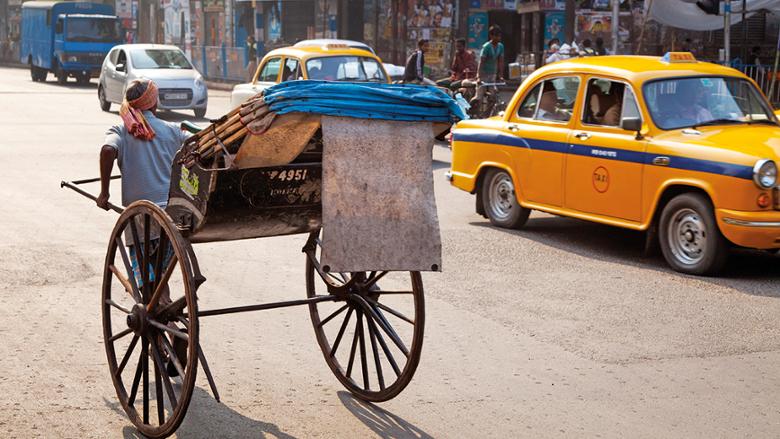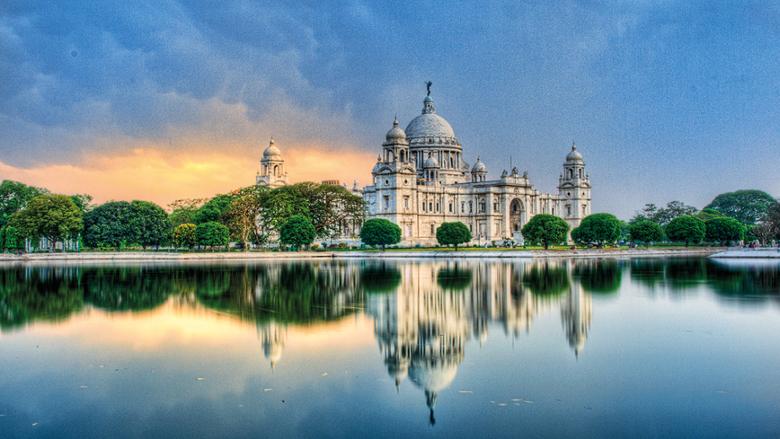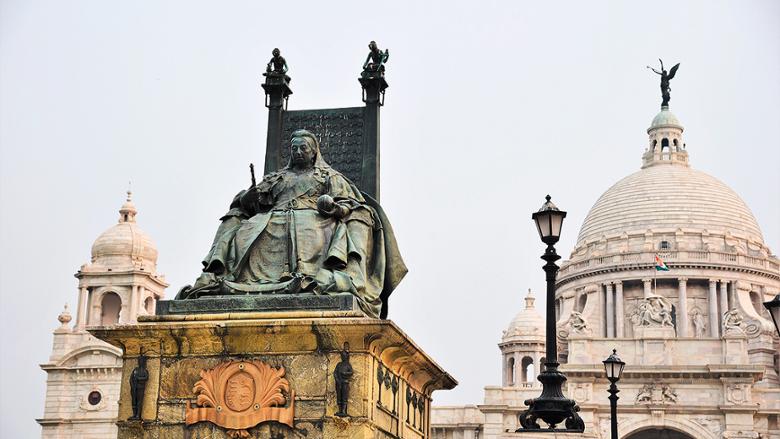Travel: Exploring Kolkata’s royal connections
Stephen McClarence explores Queen Victoria’s legacy in the former capital of the British Raj, Kolkata
A dozen selfie-obsessed twentysomethings are out in force, brandishing their smartphones. Jostling around an imposing statue in the heart of Kolkata – still called “Calcutta” by many of its citizens – they raise their phones at arm’s length, smile and pout with self-adoration. A few more images to post.
The statue commemorates an unlikely selfie star – Queen Victoria. Grandly enthroned and clutching orb and sceptre, she gazes broodily down, clearly “not amused”. For a quarter of a century, Victoria was Empress of India, though she actually never set foot in the country. There are plenty of reminders of her and the Raj she headed, however, particularly here in India’s old British capital – as I recently rediscovered over four busy days in the city.
Founded in 1690, it became the home of the East India Company, which controlled British trade in this lucrative corner of Asia. Though it was captured by Bengali forces in 1756, it was retaken by Robert Clive, and in 1772 it became the capital of British India. The great days – reflected in the city’s imposing colonial architecture – lasted until 1911, when George V travelled to India for a grand Durbar and declared that the capital would be transferred to Delhi.
To explore this past as well as the city’s present, I packed an 1892 copy of John Murray’s A Handbook for Travellers in India and Ceylon. It guided readers to Whiteway & Laidlaw (drapers), Thacker, Spink & Co (booksellers), and “lady doctors” including Miss Staley, Miss Hamilton and Miss Morice. And there was plenty of useful practical advice.
‘A good travelling servant, a native who can speak English, is indispensable... to wait on his master at hotels,’ it noted, ‘and an India-rubber hot-water bottle takes up very little room and will often be found very handy.’
In the event, I didn’t need either a servant or a hot-water bottle. My visit coincided with a heatwave that sent temperatures soaring to 42C. I wilted like a true Brit in the Tropics. As Mark Twain wrote about the city’s climate four years before Victoria’s death, it was “weather which will melt a brass doorknob”.
Scorching heat apart, Kolkata sometimes suffers from a negative image. “The Black Hole of Calcutta” is a phrase that comes all too readily to Westerners’ lips, and Kipling didn’t help by branding it “The City of Dreadful Night”. When I first visited more than 20 years ago, genned up on the missionary work of Mother Teresa, I thought I’d be facing hell on earth. It turned out very differently.
True, the infrastructure can be ramshackle, with too many crumbling buildings, a relentless lava flow of traffic and the disconcerting sight of scrawny men hand-pulling rickshaws loaded down with stout passengers. But there’s also a real vibrancy, an exhilaration – and plenty has changed in the 10 years since I was last here. The city looks noticeably cleaner and there are ever more skyscrapers and glitzy shopping malls (selling Swarovski, Calvin Klein, Hugo Boss, Burberry).
Never pausing for breath, it’s a friendly, engaging place with a rare vibrancy and beguiling spirit. It deserves as many tourists as the more marketable Delhi and Mumbai. Delhi may be the country’s administrative capital, but Kolkata is arguably its cultural and intellectual one.
To sample that, I headed for the celebrated Indian Coffee House. It’s off College Street, the traditional home of the city’s book trade, where some 4,000 stalls are piled high with stalagmites of books – The Jeeves Omnibus, Ovid’s Metamorphoses, Alex Ferguson’s autobiography, 50 Shades of Grey, Walter Scott’s novels, The Ultimate Guide to Hotel Management. The lofty Coffee House is up a dark, grubby staircase. Waiters in white uniforms with cockaded hats patrol dozens of tables where students, academics and writers are generally deep in debate, often about politics. There’s a great hubbub and much waving of arms as customers settle down for long afternoons of adda, an amalgam of high-flown philosophising and low-flying gossip.
I found half a dozen middle-aged men – including a gynaecologist, an economics professor and a homeopath – huddled around a table in the centre. ‘We come here to clear our brains and our tensions,’ said businessman Shibaji Chatterjee, a man with a deep love of his city. ‘I’m born in Calcutta,’ he added. ‘I am Calcutta!’
From there, I drove south past the Maidan, a huge “village green” where boys play cricket and herds of goats graze, to the Victoria Memorial, a vast museum whose grounds house Victoria’s selfie statue. Behind gates guarded by two imperious stone lions, it was created by Lord Curzon, one of the viceroys, as a tribute to the monarch he revered: a sort of Raj Mahal.
This domed white marble treasure house of Kolkata’s British history is full of fascinating, if not always helpfully displayed, images of the city. Here are the evocative, romanticised watercolours of Thomas and William Daniell, showing a late 18th-century Calcutta rather less seething than it is today. Here are haunting photographs by the Victorian Samuel Bourne, who travelled across India – including the Himalayas – with 50 porters carrying a portable darkroom. And here’s a marble statue of a younger Victoria, looking demurely reflective but still with orb and sceptre. Ironically, the memorial was finished in 1921, by which time the Raj had long been dwindling.
I was visiting on a public holiday, so the memorial was packed. More selfies – with me this time. ‘One picture, sir...’ Over the course of an hour, I posed around 30 times. Victoria herself could hardly have hoped for more.
Kolkata’s churches and cemeteries offer a more reflective British legacy. St Paul’s Cathedral, its dazzling white tower inspired by Canterbury’s, was completed 10 years after Victoria’s accession and has a fine window by Burne-Jones.
On a day of debilitating heat, the overhead fans whirred like helicopter blades. The building – and the earlier St John’s Church – is packed with memorials to Indian Mutiny victims and Britons who died young and often suddenly – “two monsoons” was sometimes as long as they could hope to survive.
They were “full of high hopes, rare talents and the promise of future usefulness”; blessed with “manly rectitude, a gentle disposition and noble qualities”; or achieved careers “of rare success, breeding no envy”. The stonemasons of Calcutta made a good living from British virtue and piety.
Even more evocative is South Park Street Cemetery. Giant 18th- and 19th-century obelisks, pyramids and urns are tightly packed into a sort of botanical garden of ferns, palms and potted plants. Lines of drying washing are strung between some of the monuments. One particularly poignant inscription recalls Robert Atkins from the Bengal Pilot Service, who died in 1813, aged 51; he was buried with “six of his infant children”. Crows caw, squirrels scurry and young couples canoodle. A teenage student was gazing intently at the inscriptions. Why, I asked. ‘Sir, I study India’s living history at college,’ he said. ‘I come here to study India’s sleeping history.’
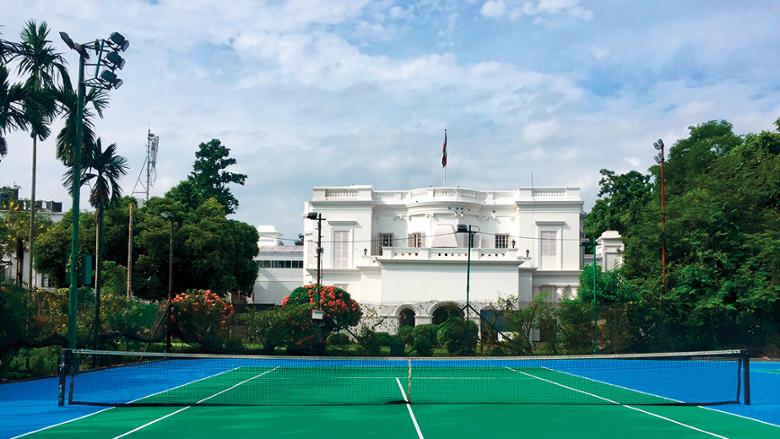
I drove further south to the celebrated Tollygunge, the city’s plushest, most exclusive club, with 350 staff, 4,000 members and a 15-year waiting list. Its glorious 108-acre parkland setting belies the hectic city beyond its gates. Founded in the last years of Victoria’s reign and now boasting a largely Indian membership, it’s preparing to celebrate its 125th anniversary. ‘We have constantly preserved the colonial environment of our club house,’ said Anil Mukerji, the debonair chief executive. ‘We don’t see any problem in nurturing our legacy. We still bring in the new year with Auld Lang Syne, though we start the evening with Hindi pop music.’
One of the city’s great living reminders of British days is the legendary Fairlawn Hotel, run for 50 years by Ted and Violet Smith, a collector’s item of a couple who put on a good show for guests. Ted, who died in 2002, was an upright ex-Army major in blazer and cravat who often talked wistfully of his native Northamptonshire, and led Fifi, a white poodle with a diamante collar, around on a lead. He was as reserved as his Armenian wife Vi – who died five years ago – was flamboyant. With her awesome coiffure and crimson-painted fingernails, the Duchess of Sudder Street, as she was sometimes called, had more than a whiff of the theatre about her, more than a hint of the grande dame, particularly when she held court in the hotel foyer.
Every available surface was painted bright green, waiters with white gloves and cummerbunds served roast chicken and rice pudding, and there were potted palms, fairy lights (“It’s the ambience, darling,” said Vi. “I love ambience”), framed London tea towels and Spitting Image dolls.
Happily, much of this has been preserved now that the Fairlawn has been bought and refurbished by the Elgin group of hotels. There’s still any amount of bric-a-brac and knick-knackery (plastic model gondolas, plaques of the Queen Mother, a small Buddha apparently moulded in raspberry jelly). A wall of signed photographs testifies to famous guests – Julie Christie, Sting, Tom Stoppard, Michael Palin, Shashi Kapoor and Gunter Grass (an intriguing thought).
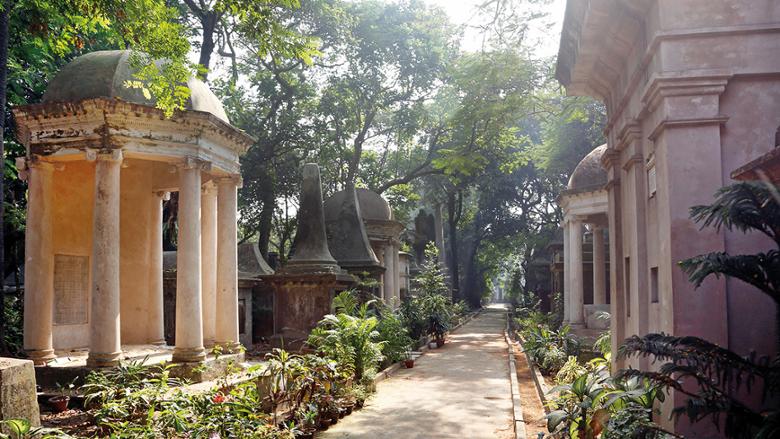
‘They’ve kept the same sort of atmosphere,’ said the Smiths’ daughter Jennifer, visiting Kolkata from her home in England. ‘But it’s not as haphazard as it was.’ As for Kolkata: ‘It’s vibrant and colourful, but it’s tough.’
Or, as Anil Mukerji at the Tollygunge Club said as he showed me around, ‘I don’t know what Queen Victoria would mean to the younger generation, but she’s part of our history.’
A round-up of the Raj
Other Indian towns and cities with British pasts often have a lingering Raj flavour. Here are a few suggestions for Raj nostalgists – three great cities, and three hill stations.
Delhi: New Delhi, the great new capital planned for George V by Sir Edwin Lutyens, retains its former elegance and splendour. Ironically, the towering statue of the king designed as its centrepiece has long been moved to Coronation Park on the city’s outskirts.
Mumbai: The grand Victorian buildings at its historic heart include the University Library, whose bells once played Home! Sweet Home! and Rule, Britannia!, and the former Victoria Terminus, the often bewilderingly busy railway station now rechristened Chhatrapati Shivaji Terminus. Many still call it VT.
Shimla: Probably the most celebrated of the British hill stations. Two highlights are the vast Viceregal Lodge and the delightful Gaiety Theatre, host to generations of amateur Gilbert and Sullivan productions. When he was stationed in Shimla, Kipling acted there. Though not, apparently, very well.
Chennai: Founded in the 17th century by the East India Company, this coastal city houses India's first Anglican church, St Mary's (it's also the oldest surviving British building in India). The nearby Fort Museum displays documents and pictures from the city's colonial past.
Darjeeling: In a town inseparable from tea, the main square, Chowrasta, retains plenty of period charm. Old British bungalows and clubs survive. The town can still evoke another era, as does the famous Windamere Hotel (a spelling mistake cherished for generations).
Ooty: Ooty, in the beautiful Nilgiri Hills of south-west India, has a refreshing climate, a church that could slot effortlessly into the Cotswolds and the venerable Nilgiri Library, one of its rooms dominated by an imposing portrait of Queen Victoria.
The Daily Telegraph/The Sunday Telegraph

